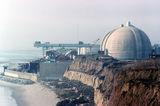Fate of Nuclear Energy in Southern California May Dim

Southern California may not go dark this summer.
But the future of the nuclear power plants that
provide the power there are in doubt. During a
conference call, Edison International said that the
San Onofre Nuclear Generating Station, or SONGS, may
retire both of its reactors along the Pacific
coastline.
Since January 2012, both SONGS units have been shut
down. Tubes located in newly-installed steam
generators had prematurely eroded -- items that had
been installed in 2009. The closure of the two units
has cost $470 million, which has been absorbed by
the region’s customers and the company’s
shareholders.
Specifically, Unit 2 was taken down for routine
maintenance. Unit 3, meanwhile, was taken off line a
few weeks later because of the leaking tubes. The
Nuclear Regulatory Commission said that the
public has never been at risk. Southern California
Edison, which is a subsidiary of Edison
International and which operates the nuclear plant,
has asked nuclear regulators if could restart Unit 2
and gradually crank it up to 70 percent of its
capacity.
The utility wants to do this in time to meet summer
demand, and is asking for a decision this month. The
company has said that it is not optimistic that its
timeframe will get met while nuclear regulators have
said that they cannot promise any decisions before
summer.
“Without a restart of Unit 2, a decision to retire
one or both units would likely be made before
year-end 2013,” says Theodore Craver, chief
executive of
Edison International in a conference call.
“There are many potential decision scenarios
involving Unit 2 and Unit 3. They all have different
implications for grid reliability, customer costs,
attainment of greenhouse gas and air quality
objectives and many other factors. We look to narrow
these uncertainties and the potential operating
scenarios for both units before the end of the
year.”
The two SONGS units provide a total of 2,250
megawatts of power for the region. The California
ISO, which schedules and delivers power supplies
along the transmission grid, has said that the
excess capacity from other plants will ease the
void. As such, natural gas facilities are generating
much of the required electricity.
“Safety of the public and our employees remains our
paramount goal,” says Craver. “Our restart plan for
Unit 2 is predicated on this. Also, San Onofre plays
an important role in the reliability of the electric
system in Southern California.”
Spilling Over
The problems are spilling over: SoCalEd and its
vendor, Mitsubishi, which was hired to install the
four steam generators at SONGS’ Units 2 and 3, have
conflicting accounts. Apparently, a defect was
discovered after the installation in 2009. That is,
there were excessive vibrations that caused the
erosion of the tubes and the small radiation leaks.
SoCalEd says that it did not know of this vibration
and that it only became aware of it in January 2012.
Mitsubishi, however, says that they both knew of the
vibrations from the get-go in 2009. The strategy
then became to minimize the problem as opposed to
install new parts or craft a new design. Citizen
groups subsequently accused both companies of being
more concerned about profits than public safety.
What’s next? If SoCalEd can’t restart Unit 2, it may
shut down the whole operation. Or, according to
public filings, it may work with Mitsubishi to
redesign the steam generators. That would take five
years.
While Mitsubishi is responsible for fixing problems,
it says that its liabilities are limited. In this
case, it says that threshold is $138 million where
as SoCalEd says the amount is much greater, or
perhaps three times more.
The possibility of losing SONGS comes atop an
announcement by Duke Energy that it will cease
operations at its Chrystal River nuclear facility in
Florida. A crack in the containment wall there only
exacerbated after nuclear engineers tried repairing
it. The 860 megawatt plant has been idle since 2009.
Meantime, Dominion Resources also plans to shed a
nuclear plant in Wisconsin.
And while the nuclear industry is showing some wear
and tear, it is also demonstrating resilience.
Southern Co. and its partners are getting ready to
finalize an $8 billion loan guarantee to construct
two nuclear units on an existing site. South
Carolina-based Scana Corp. is building two more, all
four of which could be operational by 2020.
Nuclear operators are in a period of
self-examination, especially SoCalEd. While some
units may get retired, the industry says that it is
committed to pursuing next-generation technologies
that will prove safe and effective.
EnergyBiz Insider has been awarded the Gold for
Original Web Commentary presented by the American
Society of Business Press Editors. The column is
also the Winner of the 2011 Online Column category
awarded by Media Industry News, MIN. Ken Silverstein
has been honored as one of MIN’s Most Intriguing
People in Media.
Twitter: @Ken_Silverstein
energybizinsider@energycentral.com
Copyright © 1996-2013 by CyberTech, Inc. All rights reserved.
To subscribe or visit go to: http://www.energycentral.com
To subscribe or visit go to: http://www.energybiz.com
http://www.energybiz.com/article/13/05/fate-nuclear-energy-southern-california-may-dim